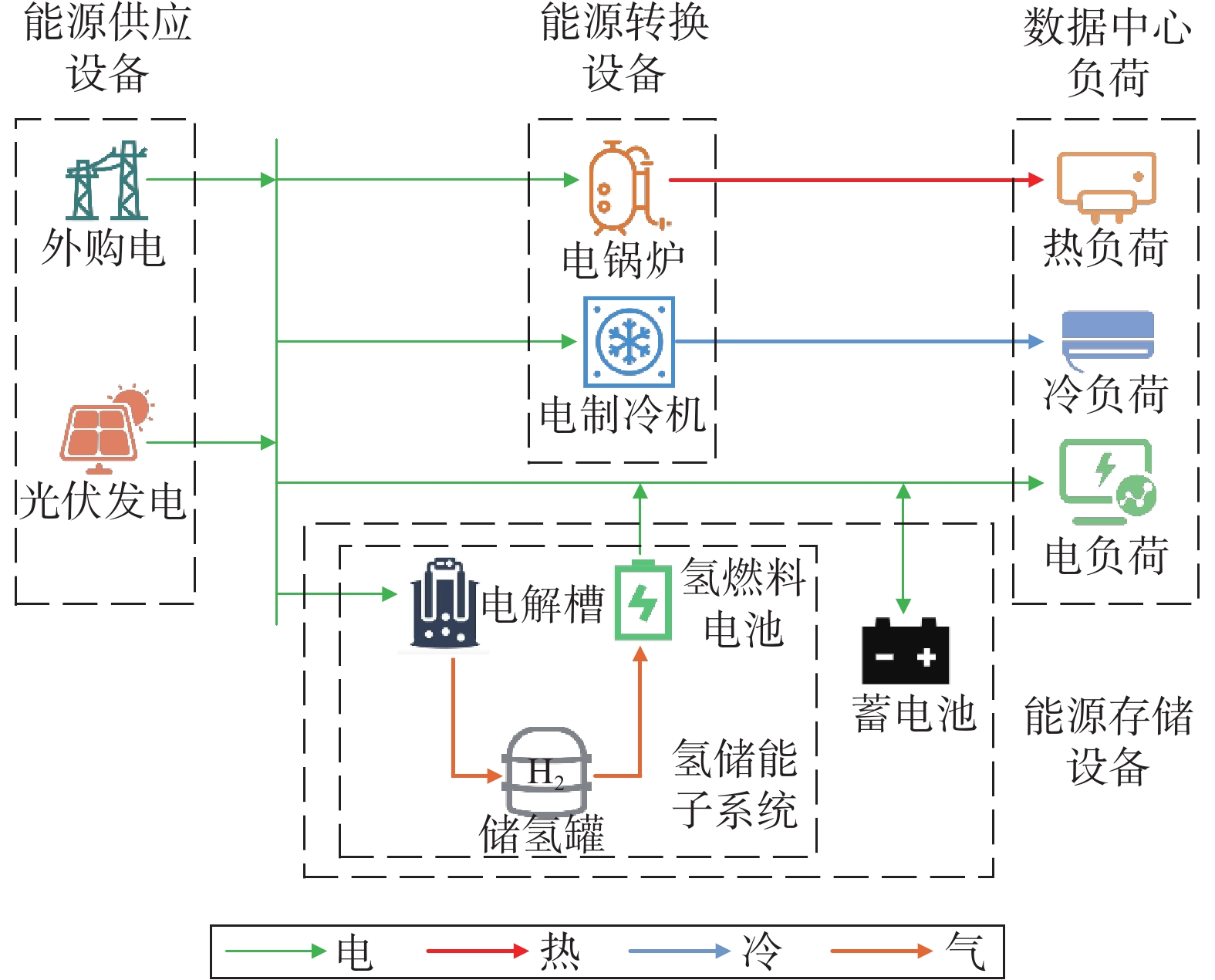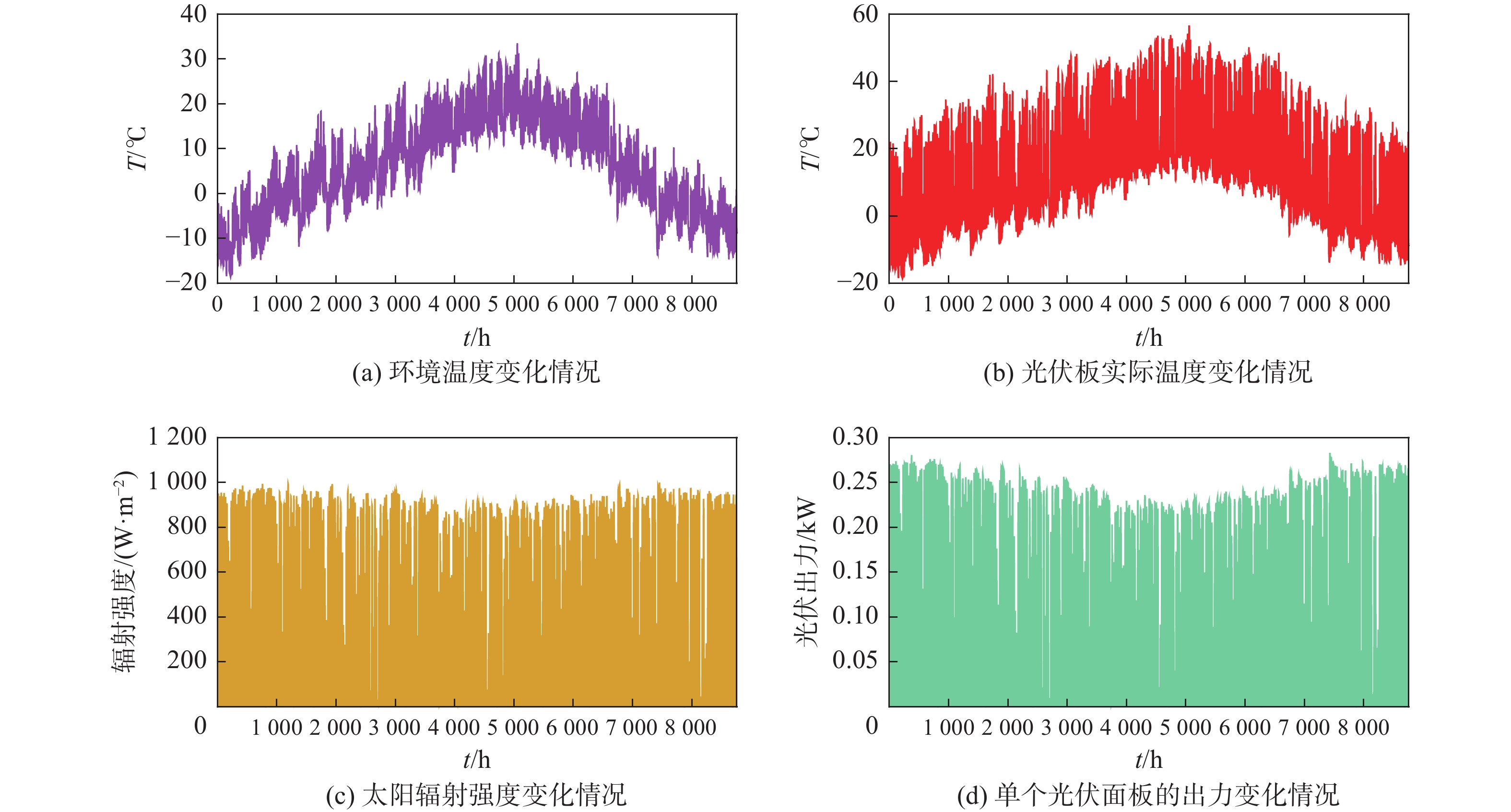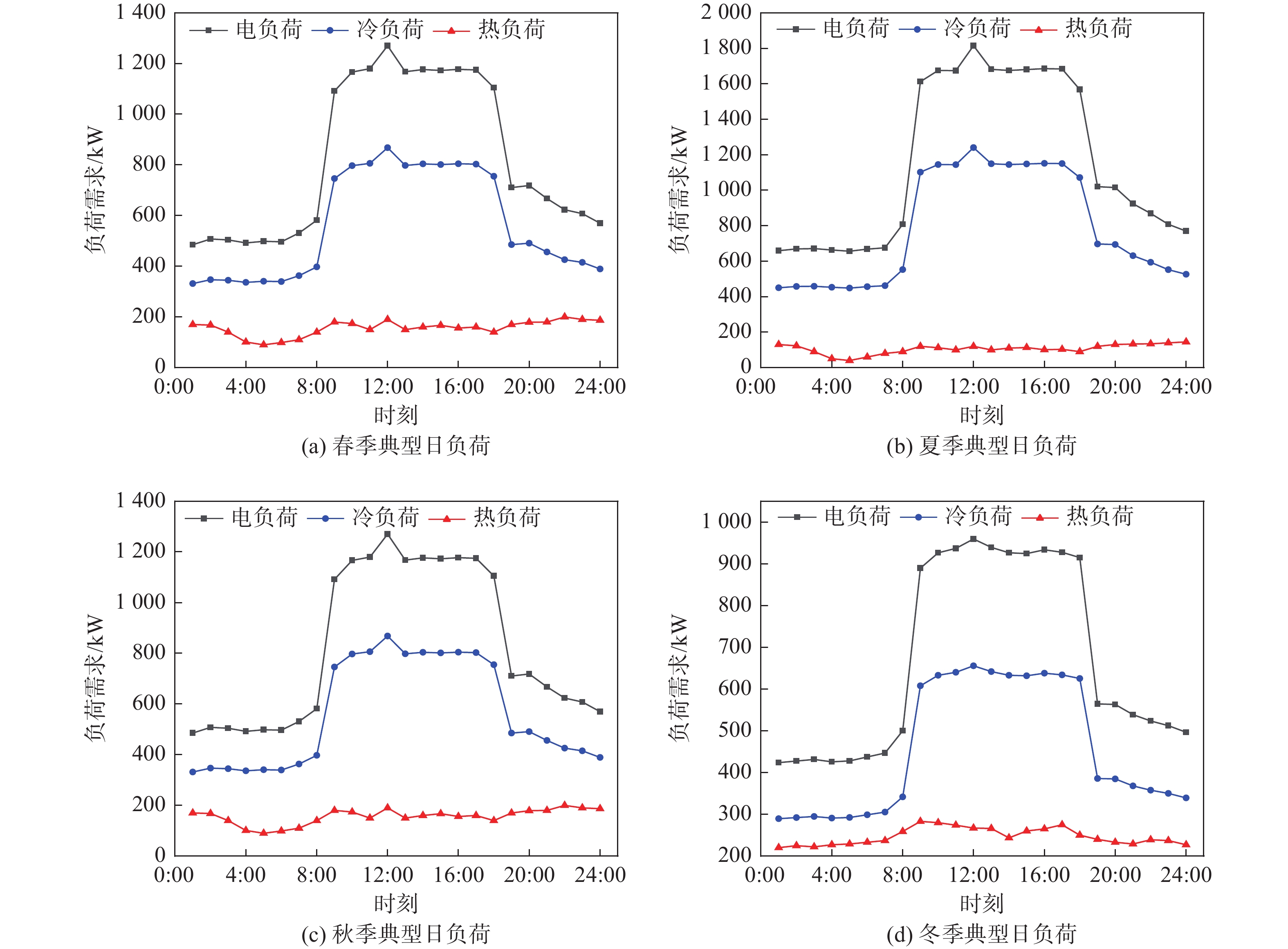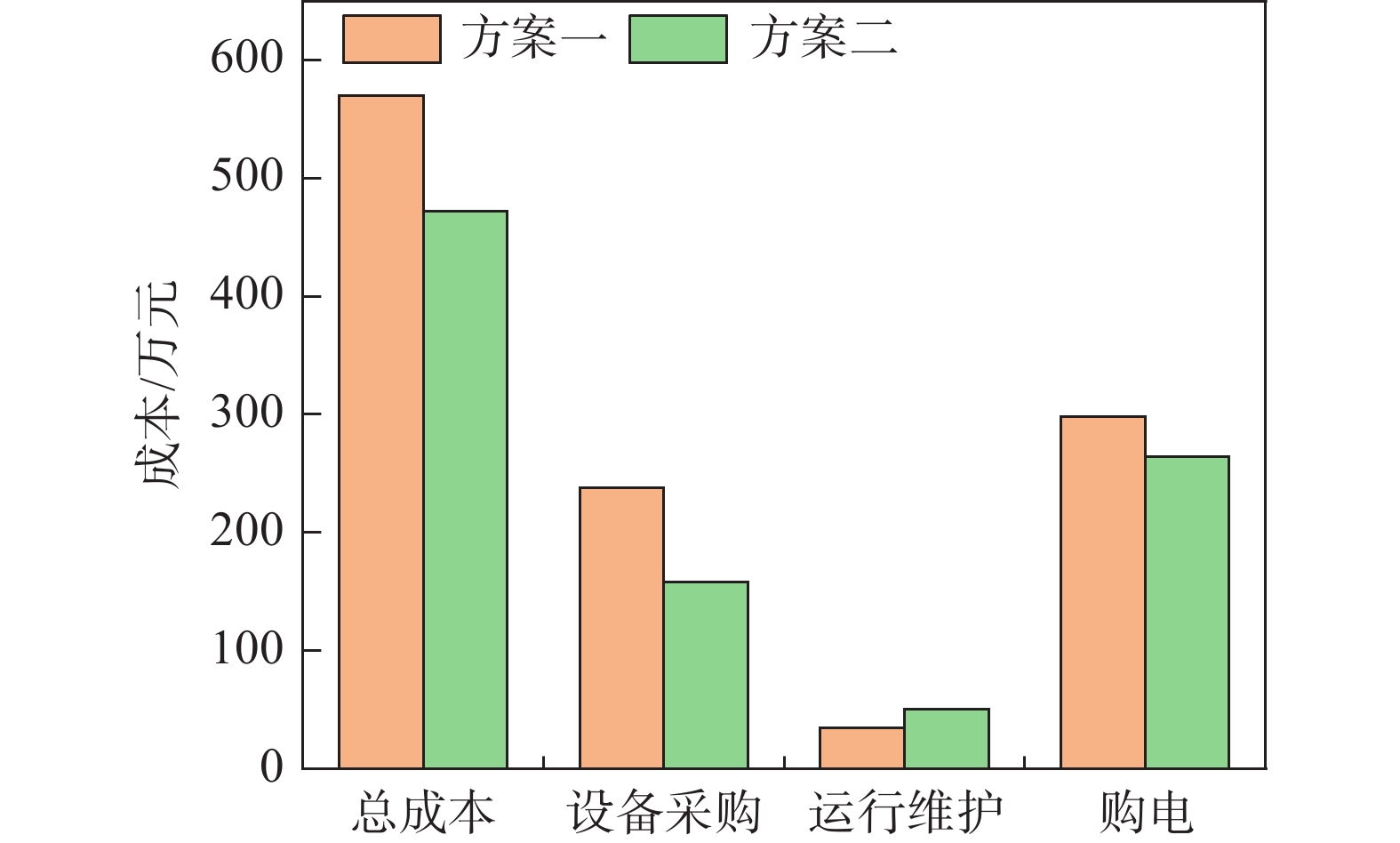-
随着数字经济时代的来临,大数据、云计算、人工智能等信息技术蓬勃发展,“新基建”成为社会高质量发展的重要保障。作为“新基建”的典型代表,数据中心的建设进程不断加快,其总用电量也在逐年增大,如图1所示[1]。根据中国信通院数据,2021年中国数据中心的总用电量为216.6 TWh,约占全社会用电量的2.6%,远超其他基础设施的用电占比[2-3]。同时,其高耗能运行所带来的碳排放问题也尤为突出。据统计,2021全国数据中心二氧化碳排放量为1.35亿t,约占全国二氧化碳总排放量的1.13%。换言之,数据中心能源系统的节能减碳将直接关系到能耗“双控”目标和社会“双碳”目标有序实现。因此,科学设计数据中心的能源系统,从规划的角度实现高效绿色用能,成为当前研究的重点和热点。
数据中心是社会发展的关键生产要素和基础性战略资源,其安全可靠运行必须有严格的保障。无论是突发故障还是极端气候的情况下,都必须具备稳定的能源电力供应能力,从而实现数据资源可靠传输和存储[4]。储能是数据中心能源系统的重要部分,可以有效降低外部能源依赖,增强供电可靠性,进而降低因偶然断电导致重要数据丢失的可能性[5]。目前,数据中心主要采用电化学储能或备用柴油发电机保障能源供应[6]。前者难以持续长时间供电,后者在运行时会产生严重的碳排放问题。以电化学储能与氢储能相结合的混合储能方式,既能解决长时间尺度稳定供电的问题,也能提高新能源消纳,降低能源存储、转化和供给中的碳排放,受到社会各界的广泛支持[7]。《新型数据中心发展三年行动计划(2021-2023年)》明确指出,支持探索利用锂电池、储氢等作为数据中心多元化储能和备用电源装置,优化数据中心用能结构[8]。由此,探索氢电耦合的数据中心能源系统规划尤为重要。
目前已经有许多学者针对数据中心的能源系统规划或储能规划展开了研究。桑丙玉等[9]和郑瑞春等[10]以经济效益为目标构建了光伏和储能电池协同优化的配置模型。Liu等[11]结合不同储能设备和智能负载分配算法的特性,以可靠性为目标实现数据中心电力系统的规划设计。卢子敬等[12]以储能系统的投资成本、风光未利用惩罚成本最小为目标对数据中心的储能系统进行优化配置。戴彦文等[13]提出一种适用于数据中心的不间断电源系统架构,并通过规划储能电池配比优化数据中心能耗与运营成本。范斐斐等[14]以燃气轮机和光伏作为主要能源供给设备,配合蓄电池储能和市电作为供能补充,探索数据中心能源系统规划布局方案。随着氢储能技术的不断发展,越来越多学者着眼于数据中心的氢能规划研究。张诚等[15]探究氢能作为数据中心备用电源、集中式电源以及分布式电源等不同应用场景的规划方案设计。Celestine等[16]也指出氢储能可以大规模、长时间满足数据中心的能源需求,是数据中心的一个可行选择。Lazaar等[17]提出计及氢储能的偏远岛屿数据中心潮汐/光伏混合发电系统的规划模型。Niaz等[18]针对数据中心耦合加氢站的场景,提出可再生能源和氢储能的规划方案。综合文献调研可知,现有研究中的储能系统大部分仍为纯电化学储能系统,少有考虑可再生能源发电耦合氢储能和蓄电池的混合储能方式;同时,也少有研究以纯绿色供能为理念,整合源储双侧资源进行规划建模,不能满足数据中心绿色能源系统建设的需要。
针对上述问题,文章可能的特色及创新点如下:
1)在蓄电池作为储能基础上,考虑加入氢储能,并利用可再生能源发电耦合氢储能来实现数据中心的长时间尺度储能。
2)考虑到绿色供用能和电能替代理念,通过采用绿电耦合光伏发电模式,辅以电能替代或清洁替代设备实现数据中心的全绿发展。
3)计及数据中心电、热、冷、储的产销平衡及能量转换,从降低成本费用和减少外部能源依赖两个维度构建一套科学可行的数据中心容量配置模型,指导规划实践。
-
文章基于绿色供能理念,以可再生能源发电及外购绿色电力为能源供应手段,以氢电耦合为能源存储方式,设计数据中心“全绿”能源系统框架,如图2所示。
数据中心能源系统主要由能源供应设备、能源转换设备、能源存储设备和负荷组成,涉及电能流、热能流和冷能流,分别用绿色、红色和蓝色线表示。为促进可再生能源发展,数据中心优先利用光伏发电,电能缺口由外部电网补充。同时,为实现进一步绿色低碳发展,能源转换设备主要包括电锅炉和电制冷机。为提高能源可靠供给,降低外部能源依赖,能量存储环节包括氢储能和蓄电池混合储能技术,主要由电解槽、储氢罐、氢燃料电池和蓄电池等设备组成。
-
光伏组件由太阳能电池组成,通过光伏效应将太阳能转化为电能。由于单个组件的发电量太少,无法满足实际项目需求,因此,通常将光伏组件串、并联连接,形成光伏阵列。光伏阵列的出力大小主要受环境温度和太阳辐射强度的影响,计算公式如下[19]:
$$ {P_{{\rm{pv}}}}(t) = \displaystyle \sum\limits_{i = 1}^N {{P_{i{\rm{,rpv}}}} \times \left( {\frac{{{R_{\rm{a}}}(t)}}{{{R_{\rm{s}}}}}} \right) \times [1 + k \times ({T_{\rm{a}}}(t) - {T_{\rm{s}}}]} $$ (1) $$ {T_{\rm{a}}}(t) = {T_{{\rm{ae}}}}(t) + 0.025\;6 \times {R_{\rm{a}}}(t) $$ (2) 式中:
$P_{\text{pv}}{\text(t)}$ ——光伏阵列产生的实际功率(kW);$N$ ——光伏阵列中的组件数量(个);$P_{i{\text{,rpv}}}$ ——组件i的额定功率(kW);${R_{\rm{a}}}{\rm{(}}t{\rm{)}}$ ——t时刻的光照强度(kW/m2);Rs ——标准环境下的光照强度(kW/m2);
k ——功率温度系数;
${T_{\rm{a}}}{\rm{(}}t{\rm{)}}$ ——光伏阵列在t时刻的温度(℃);Ts ——标准环境温度(℃);
${T_{{\rm{ae}}}}{\rm{(}}t{\rm{)}}$ ——t时刻的环境温度(℃)。 -
电锅炉主要由钢外壳、计算机控制系统、低压电气系统和电加热管组成。它主要基于电磁发热原理,向外输出蒸汽、高温水或有机热载体[20],其出力模型如下:
$$ {Q_{{\rm{eb}}}} = {P_{{\rm{eb}}}} \cdot {\eta _{{\rm{eb}}}} $$ (3) 式中:
$Q_{\text{eb}}$ ——电锅炉的制热功率(kW);$P_{\text{eb}}$ ——电锅炉的用电功率(kW);$\eta_ {\text{eb}}$ ——电锅炉电热转换效率。 -
电制冷机主要由压缩机、冷凝管、蒸发器和毛细管组成。它主要通过电能驱动压缩机加压,冷凝管液化冷却和蒸发器蒸发吸热等物理转换过程,实现电转冷的功能,其出力模型如下:
$$ {Q_{{\rm{ec}}}} = {P_{{\rm{ec}}}} \cdot {\eta _{{\rm{ec}}}} $$ (4) 式中:
${Q_{{\rm{ec}}}}$ ——电制冷机的制冷功率(kW);${P_{{\rm{ec}}}}$ ——电制冷机的用电功率(kW);${\eta _{{\rm{ec}}}}$ ——电制冷机的制冷系数。 -
氢储能设备主要指储氢过程中所涉及的设备,具体可细分为电解槽、储氢罐和氢燃料电池[21]。其中,电解槽负责电解水产生氢气;储氢罐用于氢气存储;氢燃料电池负责将氢和氧的化学能转化为电能,即电解水的逆反应。它们的换算公式如下:
$$ {Q_{{\rm{el}}}}(t) = {P_{{\rm{el}}}}(t) \cdot {\eta _{{\rm{el}}}} \cdot \Delta t $$ (5) $$ {Q_{{\rm{fc}}}}(t) = {P_{{\rm{fc}}}}(t) \cdot {\eta _{{\rm{fc}}}} \cdot \Delta t $$ (6) $$ {Q_{{\rm{hst}}}}(t) = {Q_{{\rm{hst}}}}(t - 1) + {Q_{{\rm{el}}}}(t) - {Q_{{\rm{fc}}}}(t) $$ (7) 式中:
${Q_{{\rm{el}}}}(t)$ ——电解槽在t时刻的产氢量(mol);${P_{{\rm{el}}}}{\rm{(}}t{\rm{)}}$ ——电解槽在t时刻消耗的电能(kW);${\eta _{{\rm{el}}}}$ ——电解槽的转换效率;${Q_{{\rm{fc}}}}(t)$ ——氢燃料电池在t时刻的耗氢量(mol);${P_{{\rm{fc}}}}(t)$ ——氢燃料电池在t时刻的输出功率(kW);${\eta _{{\rm{fc}}}}$ ——氢燃料电池的转换效率;${Q_{{\rm{hst}}}}{\rm{(}}t{\rm{)}}$ ——储氢罐在t时刻的存储量(mol);${Q_{{\rm{hst}}}}{\rm{(}}t - 1{\rm{)}}$ ——储氢罐在t−1时刻的存储量(mol)。 -
蓄电池是一种利用可逆的化学反应实现化学能和电能相互转换的设备。在充电时,蓄电池通过外部的电能使自身活性物质再生,将电能转化为化学能;放电时再将化学能转换为电能输出。其能源存储通用模型如下[22]:
$$ {P_{{\rm{es}},{t} + 1}} = {P_{{\rm{es}},{t}}} + \left( {{P_{{\rm{esc}},{t}}} \times {\eta _{{\rm{esc}}}} - {P_{{\rm{esd}},{{t}}}}/{\eta _{{\rm{esd}}}}} \right) \times \Delta t $$ (8) 式中:
${P_{{\rm{es}},{t}}}$ ——t时刻蓄电池充电量(kWh);${P_{{\rm{esc}}}}$ ——蓄电池充电功率(kW);${P_{{\rm{esd}}}}$ ——蓄电池放电功率(kW);${\eta _{{\rm{esc}}}}$ ——蓄电池充电能效系数;${\eta _{{\rm{esd}}}}$ ——蓄电池放电能效系数。 -
根据电力电量平衡,外部电网、自有光伏、氢燃料电池和蓄电池的输出功率之和应等于数据中心的电负荷、电锅炉、电制冷和电解槽的能量需求功率之和,其平衡约束如下:
$$ \begin{split} &P_{\rm{pv}} + P_{\rm{ele}} + I_1 \times P_{\rm{fc}}+I_2 \times P_{\rm{esd}} = P_{\rm{eload}} + P_{\rm{ec}} +P_{\rm{eb}} +\\& (1 - I_1) \times P_{\rm{el}} + (1 - I_2) \times P_{\rm{esc}} \end{split} $$ (9) 式中:
${P_{{\rm{ele}}}}$ ——购电功率(kW);${P_{{\rm{eload}}}}$ ——数据中心电负荷的消耗功率(kW);$I_1$ ——控制氢储能电解和发电动作的0~1变量;$I_2$ ——控制电化学储能充电和放电动作的0~1变量。 -
为满足数据中心供热需求,电锅炉的输出热功率应不小于所需热负荷,其平衡约束如下:
$$ Q_{\text{eb}} \geqslant Q_{\text{hload}} $$ (10) 式中:
${Q_{{\rm{hload}}}}$ ——数据中心的热负荷需求(kW)。 -
为满足数据中心供冷需求,电制冷机的输出冷功率应不小于所需冷负荷,其平衡约束如下:
$$ {Q_{{\rm{ec}}}} \geqslant {Q_{{\rm{cload}}}} $$ (11) 式中:
${Q_{{\rm{cload}}}}$ ——数据中心的冷负荷需求(kW)。 -
在能源系统供给、传输、存储和消费过程中,也会受到设备参数和场地限制,如:设备出力应小于其额定功率,能量存储需满足上下限约束,外购能量不应小于0等。
-
考虑到数据中心用来放置光伏组件的可利用空间是有限的。因此,光伏组件的安装容量受到限制:
$$ 0 \leqslant {N_{{\text{pv}}}} \leqslant N_{{\text{pv}}}^{{{\rm{max}}}} $$ (12) 式中:
$N_{\text{pv}}$ ——光伏组件的安装容量(kW);$N_{{\text{pv}}}^{{{\rm{max}}}}$ ——光伏组件的最大安装容量(kW)。 -
$$ P_j^{{{\rm{min}}}} \leqslant {P_j}(t) \leqslant P_j^{{{\rm{max}}}} $$ (13) 式中:
${P_j}(t)$ ——设备$j$ 在$t$ 时刻的实际出力(kW);$P_j^{{{\rm{min}}}}$ ——设备$j$ 的最小出力(kW);$P_j^{{{\rm{max}}}}$ ——设备$j$ 的最大出力(kW)。 -
储氢罐的约束条件主要是存储量约束:
$$ Q_{{\text{hst}}}^{{{\rm{min}}}} \leqslant {Q_{{\text{hst}}}}(t) \leqslant Q_{{\text{hst}}}^{{{\rm{max}}}} $$ (14) 式中:
$Q_{{\text{hst}}}^{{{\rm{min}}}}$ ——储氢罐的最小存储量(mol);$Q_{{\text{hst}}}^{{{\rm{max}}}}$ ——储氢罐的最大存储量(mol)。 -
蓄电池约束条件主要包括存储能量上下限以及充放电功率约束:
$$ \left\{ {\begin{array}{*{20}{l}} {P_{{\text{es}}}^{{{\rm{min}}}} \leqslant {P_{{\text{es,}}t}} \leqslant P_{{\text{es}}}^{{{\rm{max}}}}} \\ {\begin{array}{*{20}{l}} {0 \leqslant {P_{{\text{esc,}}t}} \leqslant P_{{\text{esc}}}^{{{\rm{max}}}}} \\ {0 \leqslant {P_{{\text{esd,}}t}} \leqslant P_{{\text{esd}}}^{{{\rm{max}}}}} \end{array}} \end{array}} \right. $$ (15) 式中:
$P_{{\text{es}}}^{{{\rm{min}}}}$ ——蓄电池储电量下限(kWh);$P_{{\text{es}}}^{{{\rm{max}}}}$ ——蓄电池储电量上限(kWh);$P_{{\text{esc}}}^{{{\rm{max}}}}$ ——蓄电池最大充电功率(kW);$P_{{\text{esd}}}^{{{\rm{max}}}}$ ——蓄电池最大放电功率(kW)。 -
从经济性层面来看,数据中心能源系统规划需满足成本费用最低的要求,以实现经济利润最大化。数据中心的能源成本主要涉及设备采购、系统运行维护、外购能源等费用[23],其函数表达如下:
$$ {C_{{\rm{total}}}}={C_{{\rm{pur}}}}+{C_{\rm{m}}}+{C_{{\rm{ele}}}} $$ (16) 式中:
$C_{\rm{total}}$ ——数据中心的能源成本(元);$C_{\rm{pur}}$ ——系统的设备采购费用(元);$C_{\rm{m}}$ ——系统运行维护成本(元);$C_{\rm{ele}}$ ——购电费用(元)。从外部能源依赖层面来看,数据中心对外部电网能源依赖越低,面对外电网故障情况下遭遇停电事故的可能性越小,由此,其函数表达如下:
$$ R = \displaystyle \sum\limits {{P_{{\rm{ele}}}}} /\displaystyle \sum\limits {{P_{{\rm{eload}}}}} $$ (17) 式中:
$R$ ——外部能源依赖性。考虑两个目标的权重偏好,利用权重系数对这两个函数进行集结[24],可得如下目标函数:
$$ F = \gamma \times C_{\rm{total}} + (1 - \gamma ) \times R $$ (18) 式中:
$\gamma $ ——成本目标的权重。 -
为明晰计算过程,进而验证所提模型的可操作性和有效性,本节以某地区数据中心为例进行算例分析。根据气象数据,该地全年最大光照辐射强度约1 kW/m2,平均光照辐射强度约295 W/m2;年内温度变化较大,冬季最低气温为−18.5 ℃,夏季最高气温为33.5 ℃。该地一年中环境温度、光照情况以及理论光伏发电出力的变化情况如图3所示。
数据中心春、夏、秋、冬4个季节的典型日电、热、冷负荷情况如图4所示。其中,电负荷最大值出现在夏季,约为1.815 MW。电力消耗与计算任务密切相关,主要集中在8∶00-19∶00 ;冷负荷主要由服务器的消耗电力决定,最大需求约为1.240 MW;热负荷主要为采暖和生活热水,最大值出现在冬季,约为283 kW。全年最大负荷可达3.175 MW。
主要能源设备的技术经济参数如表1所示。经济参数主要包括设备单价、运行维护成本和使用寿命等;技术参数主要包括额定功率和转换效率等。
设备名称 参数名 参数值 光伏组件[24-25] 标准环境下的额定功率/kW 0.28 温度修正系数 −0.004 衰减系数 0.008 单价/[元·(kW)−1] 7323.89 运行维护成本/[元·(kW)−1] 63.38 使用寿命/a 20 电锅炉[26] 加热效率/% 0.95 单价/[元·(kW)−1] 1050 运行维护成本/[元·(kW)−1] 17.17 使用寿命/a 20 电制冷机[24,26] 制冷性能系数 2.5 单价/[元·(kW)−1] 1100 运行维护成本/[元·(kW)−1] 18 使用寿命/a 20 电解槽[27-28] 电解效率/% 0.7 电氢转换/[mol·(kWh)−1] 8.9 单价/[元·(kW)−1] 2467.65 运行维护成本/[元·(kW)−1] 160 使用寿命/a 15 储氢罐[27] 单价/(元·m−3) 329 运行维护成本/[元·(Nm)−3] 4 使用寿命/a 20 氢燃料电池[28] 转换效率/% 0.6 氢电转换/(kWh·mol−1) 0.047 单价/[元·(kW)−1] 5037 运行维护成本/[元·(kW)−1] 420 使用寿命/a 10 蓄电池[26] 单价/[元·(kW)−1] 2000 运行维护成本/[元·(kW)−1] 28 使用寿命/a 10 Table 1. Technical and economic parameters of main equipment
为保证数据中心能源系统的绿色可靠供应,文章在能源成本和外部能源依赖权重相等的情况下,对比分析两种规划配置方案。其中,方案一主要是通过光伏发电和外购绿电提供电能,由电锅炉供热、电制冷机供冷,并采用蓄电池进行电能存储。方案二在方案一的基础上,引入氢储能设备,以蓄电池和氢储能混合储能进行电能存储。
结合公式(1)~公式(8)的设备数学模型,考虑电、热、冷、储的供需平衡约束,基于经济性和外部能源依赖性两个维度,构建出数据中心能源系统优化配置模型。导入设备参数,利用Matlab软件对上述两种规划方案进行混合整数规划求解,求解结果如表2所示。
设备名称 方案一 方案二 光伏组件/kW 2283.4 2800 电锅炉/kW 298 298 电制冷机/kW 497 497 电解槽/kW - 1213 储氢罐/Nm3 - 6108 氢燃料电池/kW - 182 蓄电池/kW 6499 632 Table 2. Planning schemes for energy system of data centers
方案一和方案二的分项成本对比如图5所示。从经济性来看,两个规划方案的年均成本分别为570万元和472万元。相较方案一,方案二的总成本支出减少约17.19%。在购买设备费用方面,方案二引入氢储能系统,大大降低蓄电池的需求,进而减少将近33.82%的成本支出。另一方面,由于方案二涉及设备类型较多,其维修费用支出高于方案一的维修费用。从外购电量来看,方案二配置电解槽、储氢罐和氢燃料电池,能够长时间存储富余的光伏发电量并满足长时间储蓄供电,大大降低对外购电的需求,电费下降近11.32%。综合来看,氢电耦合的储能形式具有更好的经济性。
从外部能源依赖来看,方案一的外部购电量约占系统总电量的39%。相较方案一,方案二对外部电网的依赖程度更低,降低约5%。由于方案二配置了蓄电池和氢储能混合储能,能够在长时间尺度进行储电,可以有效提高可再生能源的消纳,有助于减轻外部电网故障对数据中心稳定供能的影响。
-
考虑到光伏发电的清洁特性,氢储能与电化学储能的互补特性,文章构建了计及光伏发电、氢储能和电化学储能的数据中心能源系统优化配置模型。同时,通过外购绿电来满足负荷缺口,利用电能替代降低碳排放,以实现数据中心的绿色供用能。通过具体算例,利用混合整数线性规划测算数据中心最优容量优化配置,并与单一蓄电池储能场景进行对比分析,可得出以下结论。
1)氢储能和电化学储能耦合的新型储能模式可以明显降低系统供能的运行成本,减少对外部电网的依赖,有助于数据中心的经济可靠运行。
2)充分利用以光伏为主的可再生能源发电,采用电锅炉和电制冷机等电能替代模式,辅以绿电采购和绿色电能存储,可实现数据中心的全绿发展。
3)考虑成本费用和外部能源依赖构建出绿色数据中心能源系统优化配置模型,能够有效满足规划需求,从而帮助决策者更好地设计和建设数据中心能源系统。
Research on Energy System Planning of Data Center Based on Hydrogen-Electric Coupling
doi: 10.16516/j.gedi.issn2095-8676.2023.03.003
- Received Date: 2023-02-17
- Rev Recd Date: 2023-03-24
- Available Online: 2023-04-04
- Publish Date: 2023-05-10
-
Key words:
- planning optimization /
- capacity configuration /
- data center /
- hydrogen-electric coupling /
- green energy supply /
- energy saving and carbon reduction
Abstract:
| Citation: | KE Yiming, TANG Hongyu, LIU Wei. Research on Energy System Planning of Data Center Based on Hydrogen-Electric Coupling[J]. SOUTHERN ENERGY CONSTRUCTION, 2023, 10(3): 23-31. doi: 10.16516/j.gedi.issn2095-8676.2023.03.003 |


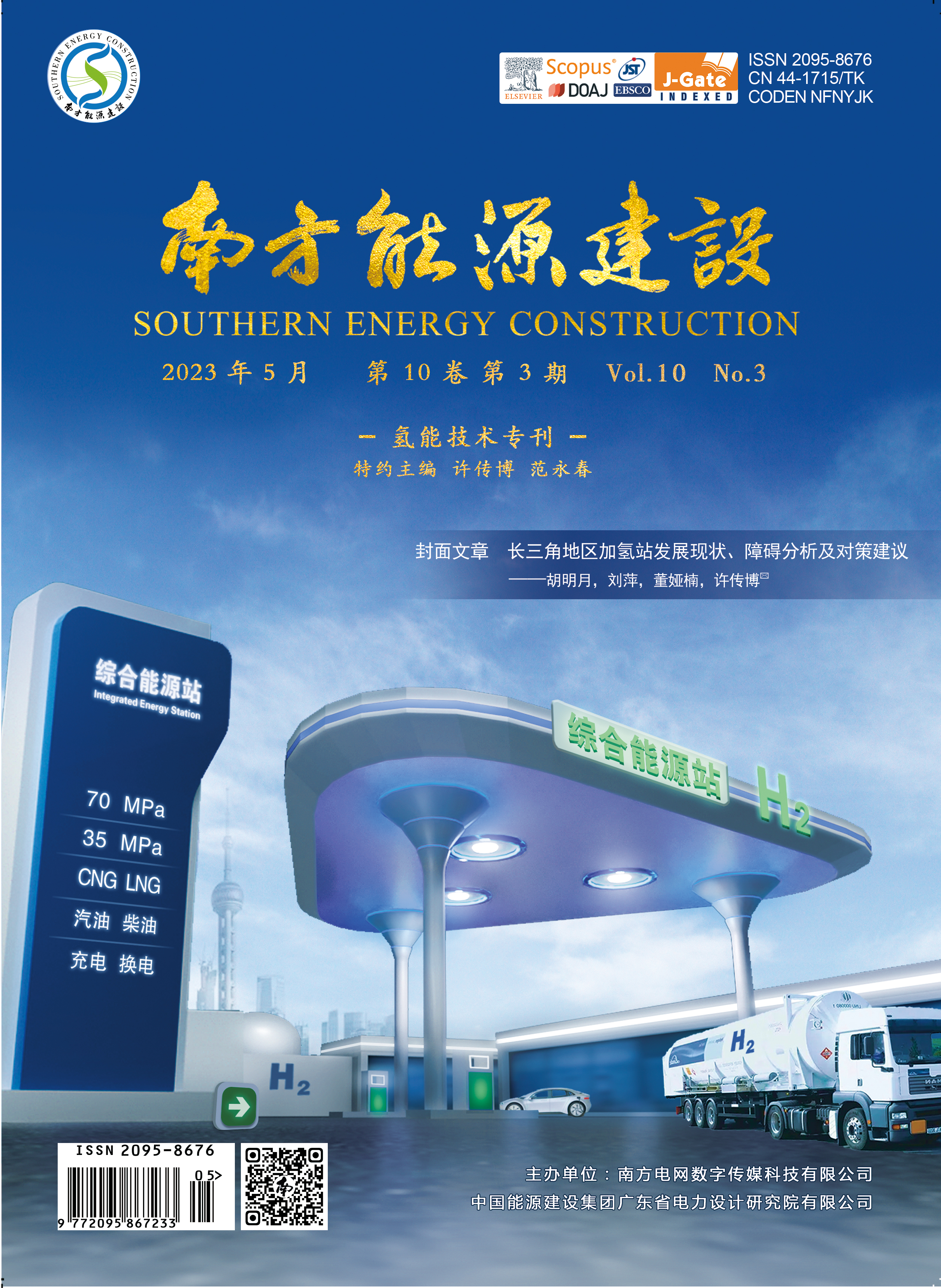

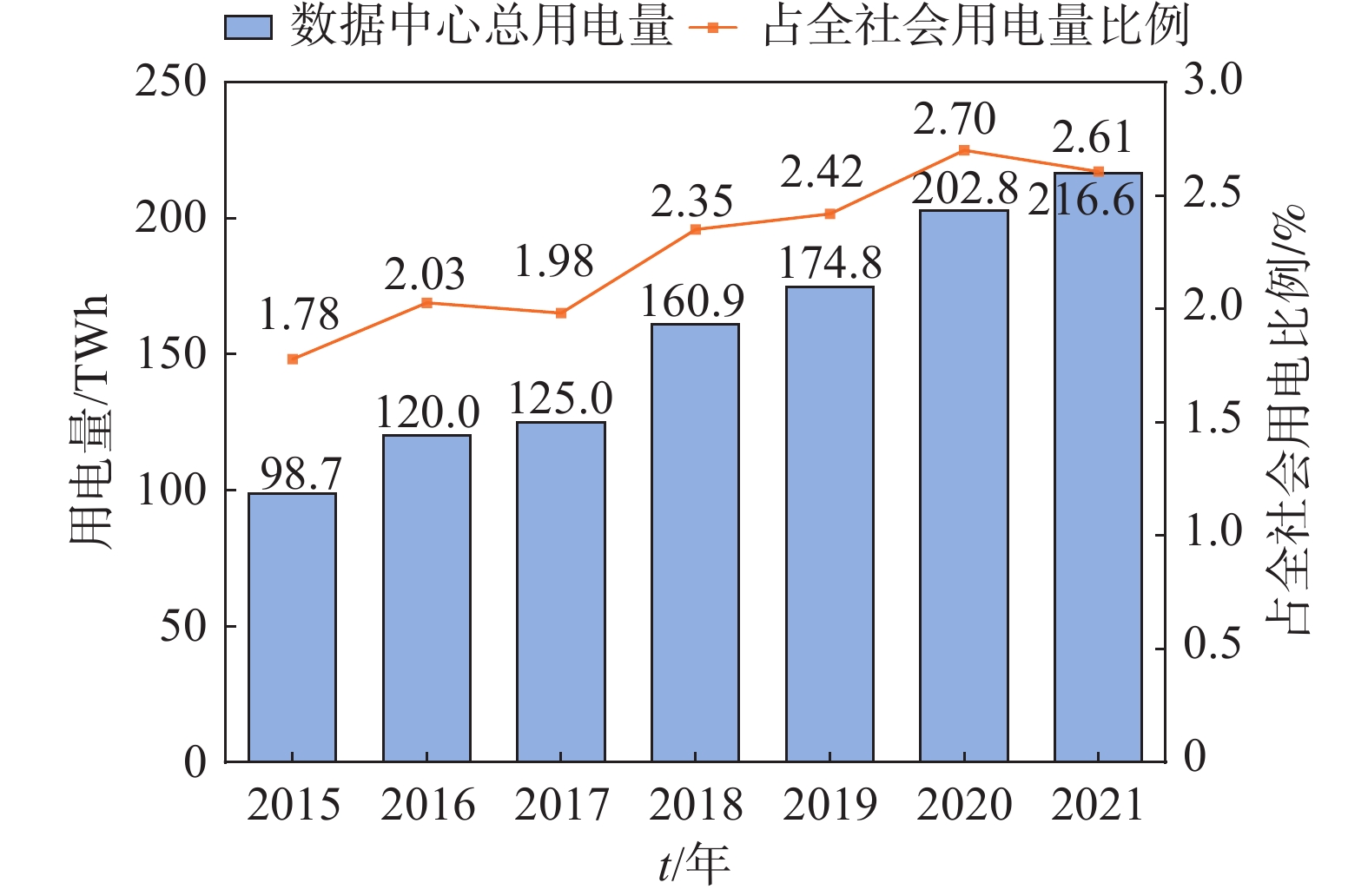

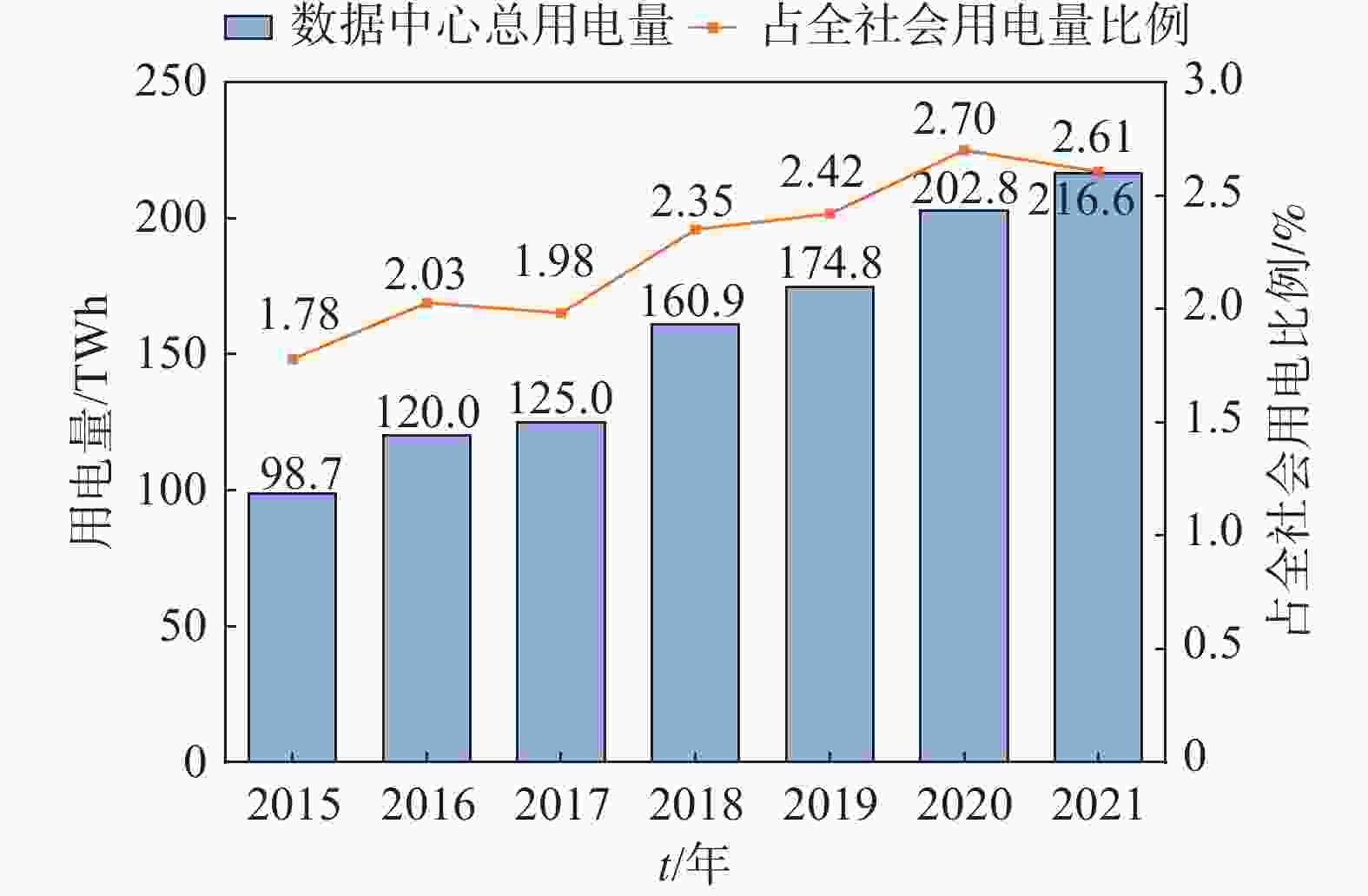
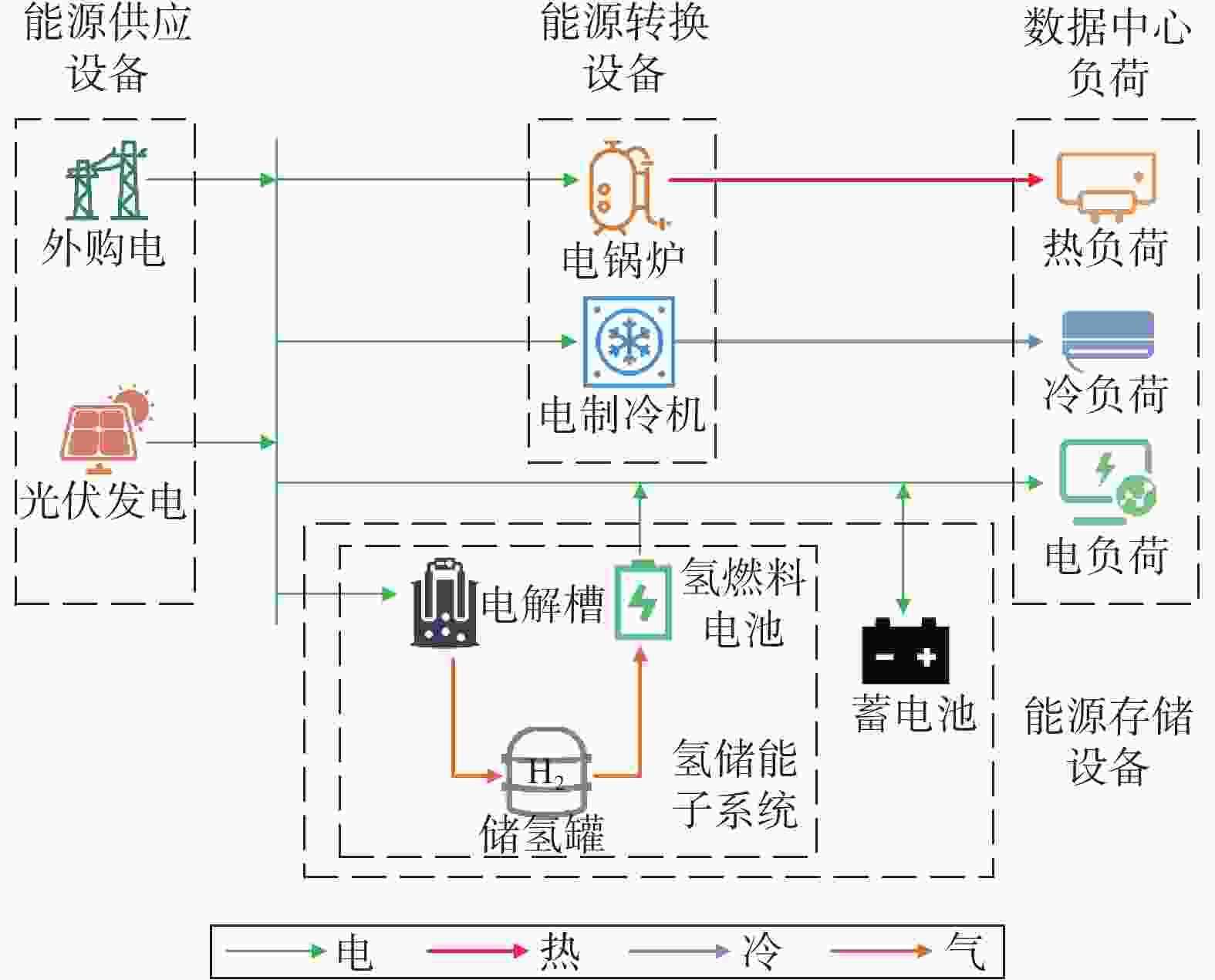






































































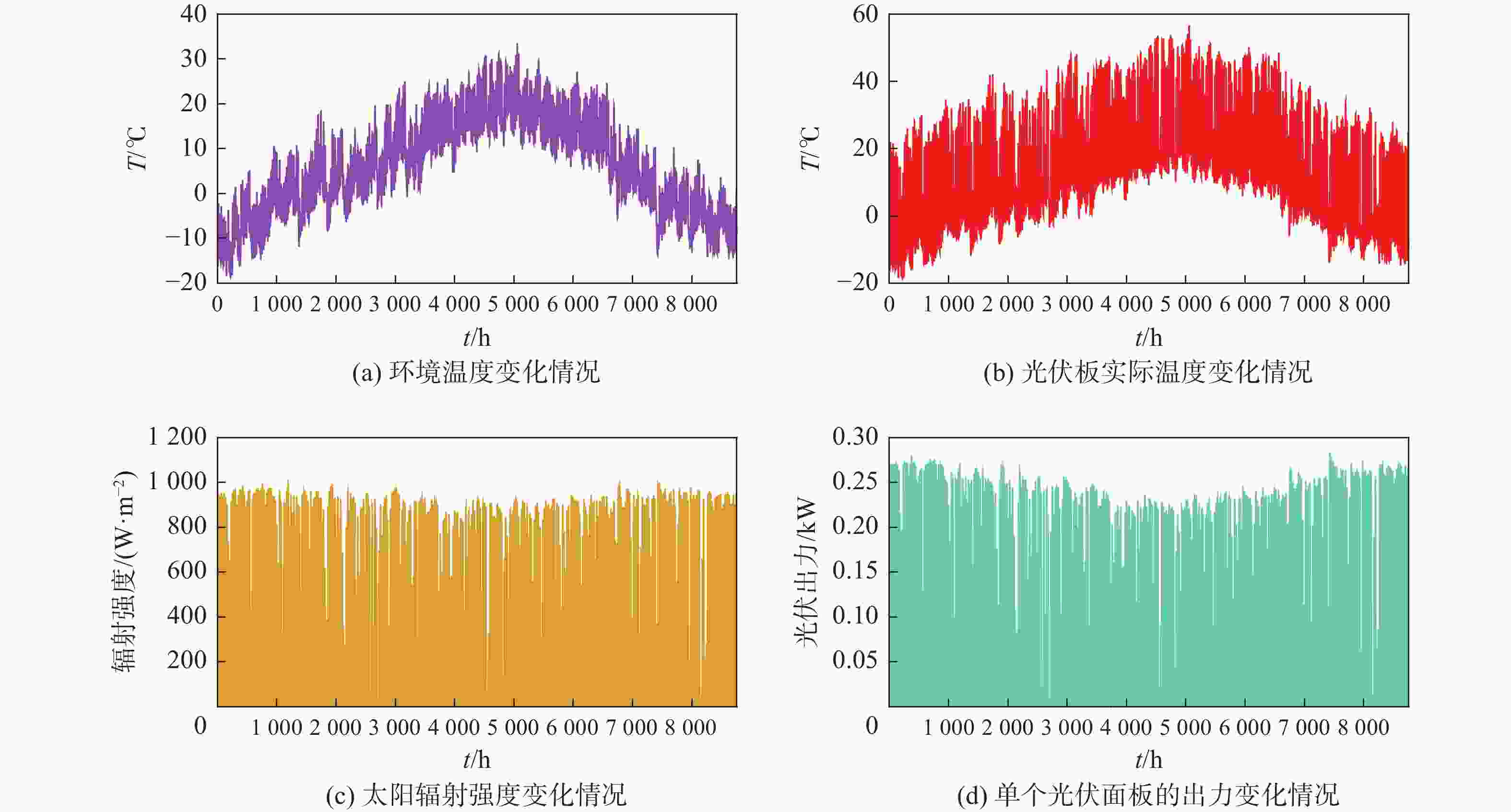
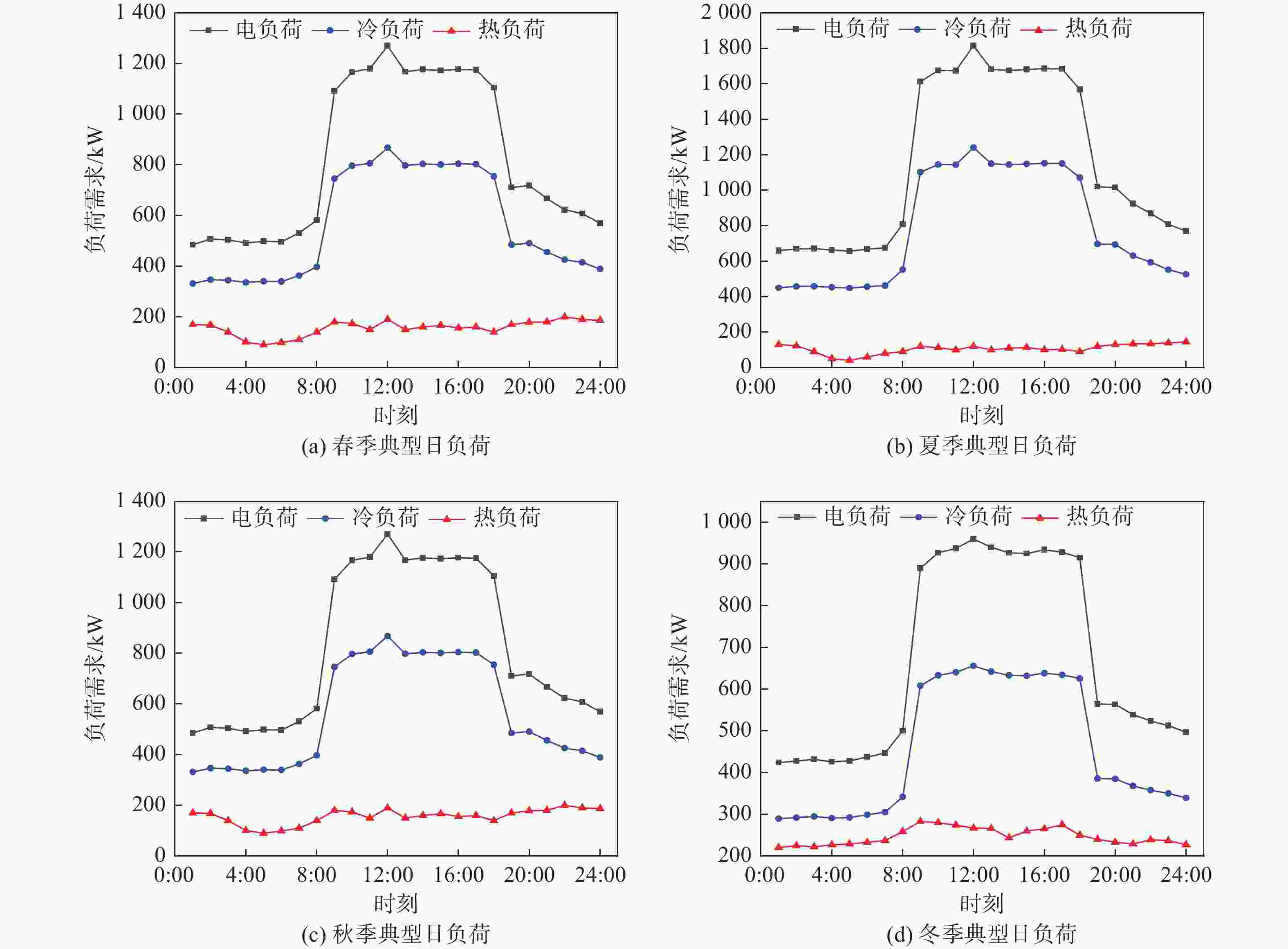
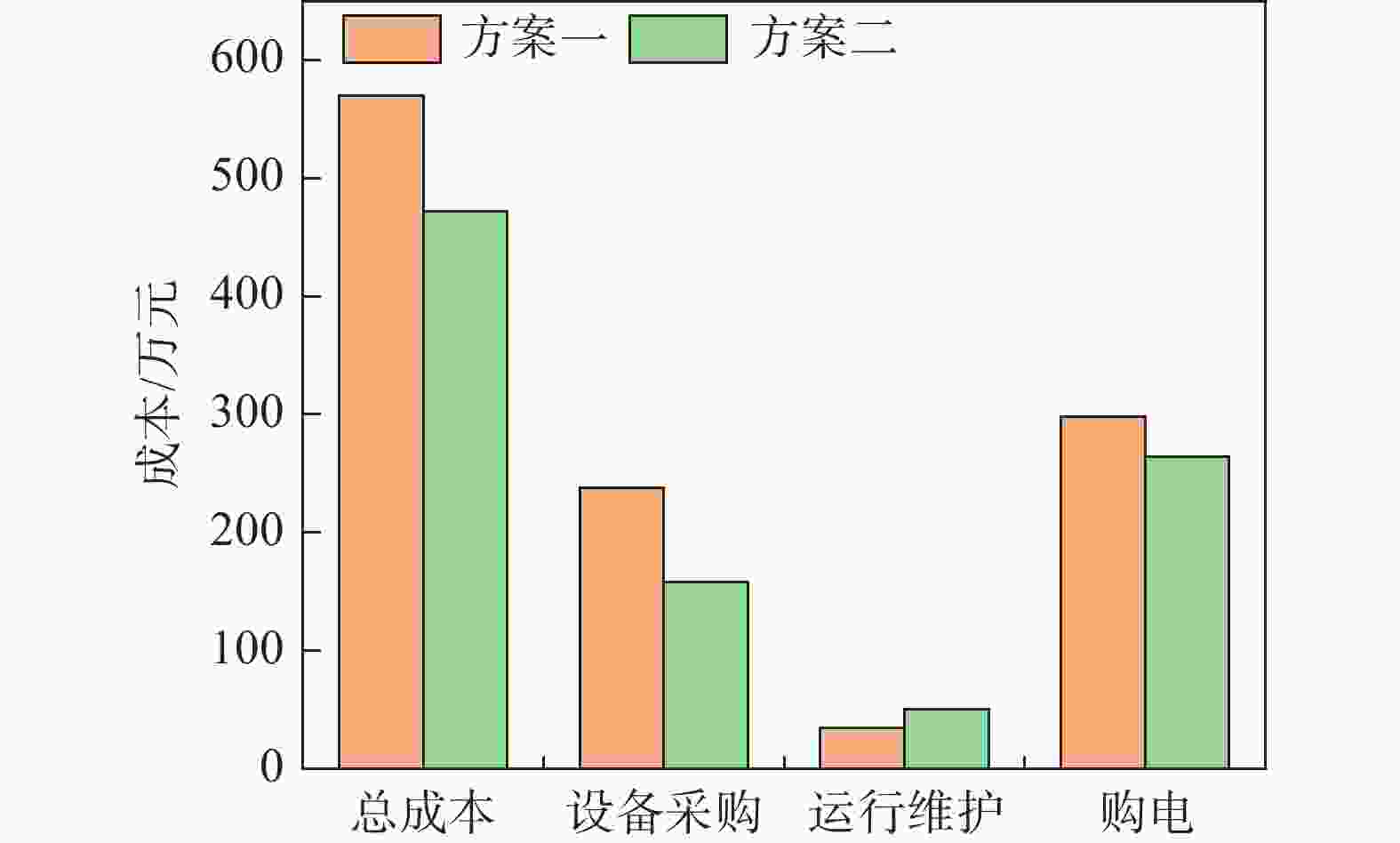

 DownLoad:
DownLoad:
